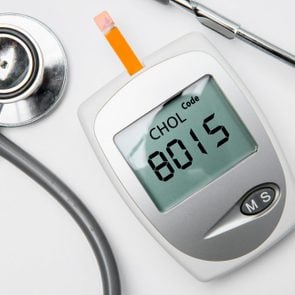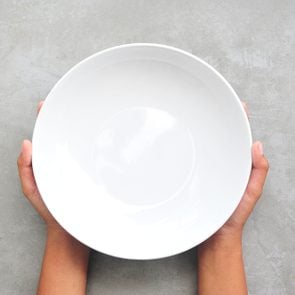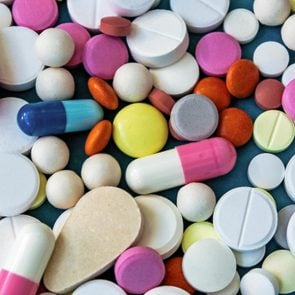7 Ways to Boost Good Cholesterol if Your HDL Level is Low
Updated: Mar. 11, 2022
HDL cholesterol is the "good" stuff, which benefits heart health. Here's how to increase it.
Which is the good cholesterol?
Cholesterol can be a silent killer. While the substance is flowing through your blood and clogging your arteries, there are few signs of a problem. That is, until a heart attack or stroke occurs.
“Cholesterol is one of the most important risk factors for cardiovascular disease,” says Indu Poornima, MD, a cardiologist with Allegheny Health Network in Pittsburgh. “Unless checked by a blood test, it will never be detected.”
Left untreated, abnormal cholesterol levels can lead to atherosclerosis (hardening of the arteries), which can slow or block blood flow to the heart.
That’s the bad news. But there’s an upside too.
Not all cholesterol is created equal, and one type can actually improve your health and lower your risk of heart problems. That’s right: as important as it is to prevent your LDL cholesterol from soaring, it’s just as crucial to make sure your protective HDL cholesterol is high enough.
Here’s what you need to know about this “good” cholesterol, target numbers to aim for, and what to do if your number is too low.
What exactly is good cholesterol?
Despite its link to heart disease, cholesterol is essential to the body.
Produced in the liver, the substance aids in digestion and metabolism. It also helps produce necessary vitamins, such as vitamin D for bone strength, and sex hormones, including estrogen and testosterone.
“Cholesterol is the building block of all cells,” explains Vicki Knight-Mathis, MD, a board-certified pediatrician in the Atlanta area.
It’s a tiny, “waxy” substance and a type of fat, or lipid. Because it’s not water soluble, it needs some help traveling through the blood, which is mostly water. So it joins up with protein.
This fat-and-protein particle is called a lipoprotein. There are two main types: high-density lipoprotein (HDL) and low-density lipoprotein (LDL).
When doctors refer to “good” cholesterol, they mean HDL. When they reference “bad” cholesterol, they’re talking about LDL, says Christopher Di Giorgio, MD, a board-certified cardiologist in New Jersey who is part of the Englewood Health Physician Network.
High levels of LDL can clog arteries, reducing blood flow and raising the likelihood of a heart attack.
HDL, on the other hand, is the cleanup crew. It collects fatty substances and excess cholesterol throughout the body and brings them back to the liver to be disposed.
The goal is to keep LDL numbers low and HDL levels high for optimal heart health.
Good cholesterol levels
Desirable cholesterol levels can vary based on a person’s health history and other risk factors. If you have heart disease or have had a heart attack, for instance, your doctor may suggest you aim for a target outside the “normal” recommendations.
Other factors that put you at risk for out-of-range cholesterol levels are a genetic predisposition to high cholesterol, a diet in unhealthy fats and low in healthy fats, obesity, and smoking.
The Centers for Disease Control and Prevention (CDC) recommends the following cholesterol targets for most adults:
LDL cholesterol: less than 100 mg/dl
HDL cholesterol: greater than or equal to 60 mg/dl
Total cholesterol: less than 200 mg/dl
Get a cholesterol test
A simple blood test can detect the milligrams of cholesterol per deciliter of blood in your body.
The CDC recommends healthy adults have their cholesterol checked every four to six years. For those with health issues, such as obesity or diabetes, or a family history of high cholesterol, tests should be done more often.
And it’s never too early to get a baseline cholesterol screening for those at higher risk.
“Children with a parental history of hypercholesterolemia [extremely high cholesterol] should get tested very early on between, 2 to 10 years of age,” advises Dr. Poornima.
For those with no risk factors, she recommends a baseline cholesterol screening between ages 17 to 20, as children transition from pediatric to adult care.
How to increase HDL cholesterol
Considering the work HDL does in your body, mopping up excess LDL cholesterol so that it can’t clog your arteries, it’s important to maintain adequate levels.
When HDL is too low—below 45 mg/dl in women and 40 mg/dl in men—your risk of atherosclerosis, heart attack, and stroke increases.
But there are steps you can take to elevate your levels of HDL cholesterol. Our medical experts outline seven steps to a healthy heart.

Get off the couch
Activity that gets the heart pumping and the body moving is the primary way to raise HDL levels.
This does not mean training for marathons and hours of kickboxing. Even small steps can yield big results, says Alicia Romano, a clinical registered dietitian at Tufts Medical Center in Boston.
“As little as 60 minutes of moderate-intensity aerobic exercise a week have been shown to [help raise] HDL,” she says. “That’s only 20 minutes three days a week … and totally reasonable!”
Take a walk around your neighborhood, or trying biking instead of driving, when possible, to add exercise into your daily schedule.
Shed the excess pounds
The increasing rate of obesity in the United States is the No. 1 cause of cholesterol-related issues, says Dr. Knight-Mathis. Nearly 40 percent of Americans are considered obese; nearly 10 percent are severely obese, at 100 pounds over their optimal weight.
The Covid-19 pandemic made the situation even worse.
“Over 50 percent of U.S. adults reported weight gain during Covid,” says Dr. Knight-Mathis, whose practice focuses on adolescents. “The most frequently cited number is 15 pounds, but it is likely even higher.”
Extra weight leads to more cholesterol production in the liver, including LDL. When cholesterol production shifts into high gear, there’s a whole lot of “bad” LDL for HDL to vacuum up, and it gets overwhelmed.
“Extra weight also increases the risk for diabetes, which is associated with worsening cholesterol,” Dr. Knight-Mathis says.
Extinguish the cigarettes
According to the CDC, smoking is a major cause of cardiovascular disease. In fact, it is the direct cause in 25 percent of deaths from cardiovascular disease.
More important for those with low HDL, smoking causes HDL levels to drop even more.
And smoking causes the thickening and narrowing of blood vessels, making the job of the HDL to clean up excess lipids even more difficult.
And it’s not just the smoker who suffers the health impacts. According to the CDC, breathing in secondhand smoke can be just as bad.
Once you quit smoking, you’ll see nearly immediate health benefits. According to the American Heart Association, in two weeks your blood circulation begins to improve, allowing HDL levels to also rise.
Eat heart-healthy fats
If your shelves and drawers are full of processed foods, meats, and sugary concoctions, your cholesterol levels are having a field day.
A diet chock-full of trans fats and saturated fats can cause a drop in HDL levels and a boost in LDL levels, says Romano.
Check the nutrition labels carefully and avoid anything containing “partially hydrogenated oils.” Those are trans fats.
Instead, look for monounsaturated or polyunsaturated fats. These healthy fats are found in vegetable oils (think olive, canola, flaxseed, safflower, sunflower, peanut, soybean, and sesame oils), avocado, nuts and seeds, fish, and tofu.
Saturated fats include the fat found in dairy, bacon, sausage, and the skins of poultry and meat. It’s also in tropical oils, like palm and coconut oils. Try to limit saturated fat in your diet.
Rotate in fatty fish, like tuna or salmon, instead of meat. And use sunflower oil or olive oil instead of grease or butter when frying.
It’s all about moderation, says Romano. Fried and greasy foods may taste great, but they can wreak havoc on your HDL levels.
“There are not necessarily individual foods that will keep HDL in check,” she notes. “Rather, there are collective patterns an individual can adapt in their diet and lifestyle to aid in improved levels of HDL and LDL.”
Fill your diet with plant-based foods
Your liver makes all the cholesterol your body needs to function. So any cholesterol you get from your diet is extra, which is why dietary cholesterol can lead to high LDL levels. And that leads to a decline in HDL.
Animal-derived foods—meat, poultry and dairy products—all contain dietary cholesterol and should be consumed sparingly, says Romano.
It’s fine to have hamburger and fries on occasion, but she recommends more fruits and vegetables (raw, frozen, or canned), whole grains (think oatmeal, 100 percent wheat bread, and brown rice), tofu, beans, seeds, and nuts, all of which will help increase your HDL levels.
The goal, says Romano, is a lifestyle focused on managing cholesterol, which will likely mitigate other health issues as well.
“Adapting a diet that incorporates a variety of enjoyable and accessible foods is very much in line with general recommendations for decreased risk of many chronic diseases,” she says.
If you drink, consider a glass of wine
While the jury is still out on this recommendation, several studies over the past few decades have suggested that moderate alcohol consumption may help cholesterol management.
Specifically, animal studies have found that a compound called resveratrol, found in grapes and red wine, has a positive impact on coronary arteries.
“Moderate use of alcohol has been linked with higher HDL levels,” Romano explains. “[Moderate] would be up to one drink a day for women and men.”
While the results are promising in animal studies, human trials are still gathering information. Until then, researchers can’t say for certain whether a nightly glass of pinot noir will raise your HDL cholesterol.
Too much alcohol can be bad for your heart, and your health in general, so moderation is key.
“If you do not drink, I do not recommend that you start to drink to raise your HDL cholesterol,” says Romano.
Talk to your doctor about medications
Sometimes medications are needed to get cholesterol levels under control.
“For some people, no matter how meticulous they are with their diet, and no matter how much time they spend in the gym, their cholesterol levels are going to be problematic,” says Dr. Di Giorgio.
Most cholesterol medications lower LDL rather than raise HDL levels.
The combination of LDL-lowering medications and a healthy lifestyle will cause HDL to naturally rise.
Statins are the most common go-to medications for cholesterol management, according to the American Heart Association. They work by preventing cholesterol from forming in the liver. This, in turn, reduces the amount of cholesterol circulating in the blood.
If statins fail to lower LDL cholesterol to target range, doctors will look to non-statin medications.
Ezetimibe (Zetia) is the most commonly used non-statin agent, and it works to prevent cholesterol from being absorbed in the intestines. Another option are newer, injectable medications called PCSK9 inhibitors.
The drug niacin, or vitamin B3, can raise HDL when taken at higher doses. However, it can also cause unpleasant side effects, including what’s called a niacin flush.
Tackling cholesterol levels
There’s a good chance that if your HDL cholesterol level is too low, your LDL levels is too high. When faced with simultaneous low “good” cholesterol and high “bad” cholesterol, doctors often treat both issues as equally important.
“We address both [with] medications focused on treatment of high LDL and lifestyle changes as the only way to address the low HDL,” explains Dr. Poornima.
Thankfully, out-of-range cholesterol levels are manageable. If you’re willing to change your lifestyle for the healthier, you’ll likely watch your HDL cholesterol level rise.
















